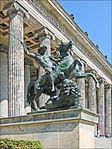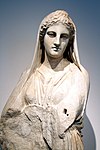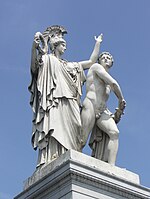Berlin Foundry Cup
5th-century BC worksAncient Greek sculptureArchaeological discoveries in ItalyIndividual ancient Greek vases

The Berlin Foundry Cup (German: Erzgießerei-Schale) is a red-figure kylix (drinking cup) from the early 5th century BC. It is the name vase of the Attic vase painter known conventionally as the Foundry Painter. Its most striking feature is the exterior depiction of activities in an Athenian bronze workshop or foundry. It is an important source on ancient Greek metal-working technology.
Excerpt from the Wikipedia article Berlin Foundry Cup (License: CC BY-SA 3.0, Authors, Images).Berlin Foundry Cup
Platz der Märzrevolution, Berlin Mitte
Geographical coordinates (GPS) Address Website Nearby Places Show on map
Geographical coordinates (GPS)
| Latitude | Longitude |
|---|---|
| N 52.519 ° | E 13.398 ° |
Address
Museumsinsel
Platz der Märzrevolution
10117 Berlin, Mitte
Germany
Open on Google Maps









